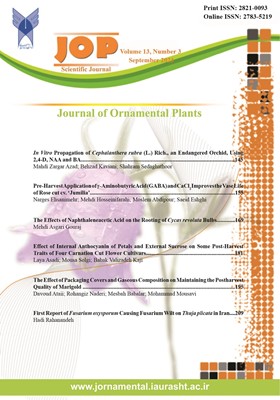-
-
فهرست مقالات
-
دسترسی آزاد مقاله
1 - <i>In Vitro </i>Propagation of <i>Cephalanthera rubra</i> (L.) Rich., an Endangered Orchid, Using 2,4-D, NAA and BA
Mahdi Zargar Azad Behzad Kaviani Shahram Sedaghathoor -
دسترسی آزاد مقاله
2 - Pre-Harvest Application of γ-Aminobutyric Acid (GABA) and CaCl2 Improves the Vase Life of Rose cut cv. ‘Jumilia’
Narges Ehsanimehr Mehdi Hosseinifarahi Moslem Abdipour Saeid Eshghi -
دسترسی آزاد مقاله
3 - The Effects of Naphthaleneacetic Acid on the Rooting of <i>Cycas revoluta</i> Bulbs
Mehdi Asgari Gouraj -
دسترسی آزاد مقاله
4 - Effect of Internal Anthocyanin of Petals and External Sucrose on Some Post-Harvest Traits of Four Carnation Cut Flower Cultivars
Laya Asadi Mousa Solgi Babak ValizadehKaji -
دسترسی آزاد مقاله
5 - The Effect of Packaging Covers and Gaseous Composition on Maintaining the Postharvest Quality of Marigold
Davoud Ataii Rohangiz Naderi Mesbah Babalar Mohammad Mousavi -
دسترسی آزاد مقاله
6 - First Report of <i>Fusarium oxysporum</i> Causing Fusarium Wilt on <i>Thuja plicata </i>in Iran
Hadi Rahanandeh
-
حقوق این وبسایت متعلق به سامانه مدیریت نشریات دانشگاه آزاد اسلامی است.
حق نشر © 1403-1400







